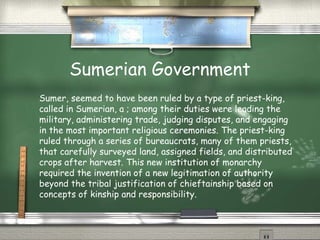Presentation1
- 1. Mesopotamian PowerPoint This PowerPoint will show you all about the civilizations in Mesopotamia
- 2. Sumer
- 3. The Writing Of Sumer The Writing of Sumer was called Cuneiform it was drawn with wedge shapes that were drawn on soft clay.
- 4. Sumerian Religon The Sumerians worshipped: Anu?as the full time god, equivalent to "heaven" - indeed, the word "an" in Sumerian means "sky" and his consort?Ki, means "Earth". Enki?in the south at the temple in?Eridu. Enki was the god of beneficence, ruler of the freshwater depths beneath the earth, a healer and friend to humanity who was thought to have given us the arts and sciences, the industries and manners of civilization; the first law-book was considered his creation, Enlill, lord of the ghost-land, in the north at the temple of?Nippurr. His gifts to mankind were said to be the spells and incantations that the spirits of good or evil were compelled to obey, Inannaa, the deification of Venus, the morning (eastern) and evening (western) star, at the temple (shared with An) at Uruk. The sun-god?Utuu?at?Sippar. the moon god?Nanna?at?Ur.
- 5. Sumerian Government Sumer, seemed to have been ruled by a type of priest-king, called in Sumerian, a ; among their duties were leading the military, administering trade, judging disputes, and engaging in the most important religious ceremonies. The priest-king ruled through a series of bureaucrats, many of them priests, that carefully surveyed land, assigned fields, and distributed crops after harvest. This new institution of monarchy required the invention of a new legitimation of authority beyond the tribal justification of chieftainship based on concepts of kinship and responsibility.
- 6. Division of Labor & Social Classes Of Sumer Sumerian society adhered to a caste system comprised of three classes:?amelu,?mushkinu, and slaves. The?amelu?were the at the top rung of the caste system. Government officials, professional soldiers, and priests were found in this class. Under the?amelu?were the?mushkinu, the middle class of Sumerian society. Themushkinu?were comprised of shopkeepers, farmers, merchants, and laborers. The?mushkinu?were the largest of the three classes. A large disparity existed between the rich and the poor, but even the poor owned their own land and livestock. The slaves were the ones that lived closest to the water and was owned by Sumer.
- 7. SumerĄŊs Economy By about 3000 BC, the Sumerians were drawing images of tokens on clay tablets. At this point, different types of goods were represented by different symbols, and multiple quantities represented by repetition. Three units of grain were denoted by three 'grain-marks', five jars of oil were denoted by five 'oil-marks' and so on.
- 8. Sumerian Art and Architecture Architecture is probably the oldest serious architecture (not just building houses and barns) in the world. People living in the area between the?Tigris and the Euphrates rivers?(modern Iraq) began to build really big, substantial buildings about 3500?BC. Because there's practically no?building stone?in this area, but there's lots of?clay, Sumerian architects built their buildings out of?mud-brick?or fired brick. From Sumer have come examples of fine works in marble, diorite, hammered gold, and lapis lazuli. Of the many portraits produced in this area, some of the best are those of Gudea, ruler of Lagash.
- 9. Assyria
- 10. Assyrian Writing Assyrians have used two languages throughout their history: ancient Assyrian (Akkadian), and Modern Assyrian (neo- syriac). Akkadian was written with the cuneiform writing system, on clay tablets, and was in use from the beginning to about 750 B.C.. By 750 B.C., a new way of writing, on parchment, leather, or papyrus, was developed, and the peop.le who brought this method of writing with them
- 11. Assyrian Religion Assyrians have practiced two religions throughout their history: Ashurism and Christianity. Ashurism was, of course, the first religion of the Assyrians. The very word Assyrian, in its Latin form, derives from the name of Ashur, the Assyrian god. Assyrians continued to practice Ashurism until 256 A.D, although by that time, most Assyrians had accepted Christianity. Indeed, Assyrians were the first nation to accept Christianity, and the Assyrian Church was founded in 33 A.D. by Thomas, Bortholemew and Thaddeus.
- 12. Assyrian Goverment The Assyrian government was very militaristic and had a monarchy. It was the Babylonians that created the code of Hammurabi. The Assyrians were the first know terrorists and were very brutal to their enemies. They tortured prisoners and slaves. The government was successful because the Assyrians built roads and started a postal service that enabled faster communication.
- 13. Assyrian Division Of Labor and Social Classes The Assyrians because of their many victories against their opponents inherited wealth and prosperity for ages. The royal family was extremely large since their ancestors trace back over 2000b.c. Even the middle class was traced to be much more wealthier than any other empires nearby which were some of the wealthiest in their time. Poverty was not an issue for them. However, the Assyrians were very particular that every citizen had to obey the laws of Mesopotamia and live respectfully together while the powerful empire fought wars with their unbreakable chariots. If a citizen did not pay their taxes or did not follow the laws they would be enslaved.
- 14. Assyrian Economy Assyria, and then created an intricate system of irrigation that would eventually feed their thriving agriculture. Soon some of the small villages developed into larger cities, and these cites would eventually serve as trade and craft centers, driving Assyria's budding economy.
- 15. Assyrian Architecture The structures were built usually on artificial mounds, and approached, it is supposed, by great flights of steps (of which remains composed of black basalt have been found at Khorsabad). They consist of series of halls and chambers of no great size.
- 16. Babylon
- 17. Babylonian Writing The writing in Babylon was the same as the ones I explained before they used cuneiform the writing on soft clay using triangles and such.
- 18. Babylonian Religion Babylon had many religious beliefs in gods there were different gods that represented different things such as Sun, Fresh water, Salt Water, and Wind.
- 19. Babylonian Government The New Empire government of Babylon adopted many of the Assyrian imperial practices, which probably contributed to its own short life. The king had overall administrative power, in addition to his central role in important religious rituals. Governors ruled important provinces on behalf of the king, but most of these were Babylonians appointed from outside the local area. Local puppets were often left in place to rule local kingdoms, but this occasionally led to revolt, as in the case of Jerusalem.




















